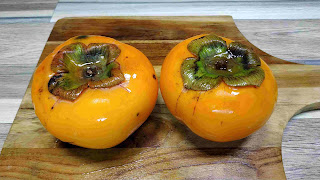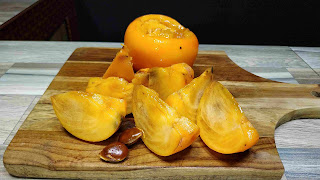Hachiya is a variety of persimmons also very appreciated, also
texas persimmon fruit and fuyu persimmon are varieties well know of persimmon fruits.
One of the curiosities about persimmon fruit, so to speak of it, is the fact that,
although it is the size of a large tomato, comparison being due to its shape,
this fruit is actually a berry as a morphological classification.
Persimmons are fruits, berries, of tree species of the Diospyros
genus in the Ebanaceae family.
A special exotic fruit with a peach-like taste, in combination with melon, is often present in the supermarket and you probably want to know more about this fruit.
 |
| Persimmons |
This oriental persimmon tree appears to date back to about 2000 years ago, being originally from China and northern Indochina, also found in northeastern India at that time.
By the 1800s, it seems that this fruit was "introduced"
to those from southern Europe and California, and then it made its presence
known on the fruit market in other countries or continents such as Australia.
Of the multitude of varieties of persimmons, only a few varietiesof fruits are edible, these being divided into astringent or sour and, less
sour.
The persimmon fruit that I purchased out of curiosity and the
desire to know this fruit, is the Jiro variety considered to be part of the
tasty and less sour varieties.
The ripe fruit looks like a tomato or like a medium-sized nectarine
measuring from 1.5 to 9 centimeters in diameter depending on the variety of persimmon.
It has a firm and glossy yellow or light reddish to brick skin, the
texture of this fruit being similar to a tomato.
The taste, as I mentioned before, is that of melon in combination
with peach but with the texture of tomato what bring the name persimmon tomato, perhaps.
NUTRITION
Japanese persimmons fruit eaten as such as contain only 70 calories and
0.19 grams of fat per 100 grams. When ripe, the fruit is sweet due to the high
content of sucrose, in the form of fructose and glucose.
These fruits are an excellent source of fiber, providing 14% of the
daily requirement for the same amount of fruit.
Among the nutrients present in this fruit are vitamins A, B1, B2,
B3, B6, B9, C, E, K, but also the minerals sodium, potassium, calcium, iron,
copper, magnesium, manganese, phosphorus and zinc.
As the very color of this fruit shows us, this fruit contains
beta-carotene, lycopene, lutein, zeaxanthin and cryptoxanthin.
As phytonutrients worth noting are flavonoids, polyphenols and
antioxidants such as catechins and gallocatechin but also betulinic acid.
HOW TO EAT PERSIMMONS
Since the peel of persimmon is sometimes a little harder than the tomato, a bit sour-bitter from the tannin content, only the flesh of the fruit can be consumed.
With a knife, cut the top of the fruit and collect the pulp of the
fruit, which is consumed as such or can be added to various culinary recipes or
soft drinks.
 |
| Persimmon fruit |
In some countries the fruit is eaten in spicy or sweet salads.
Also, in some countries the ripe fruits are dried and eaten as
delicacies like figs or other dried fruits.
That being said, I hope my article on persimmons has given you some
notable information about it.
Don't forget to like and subscribe this blog for more interesting
articles.
See you soon!
Comments
Post a Comment